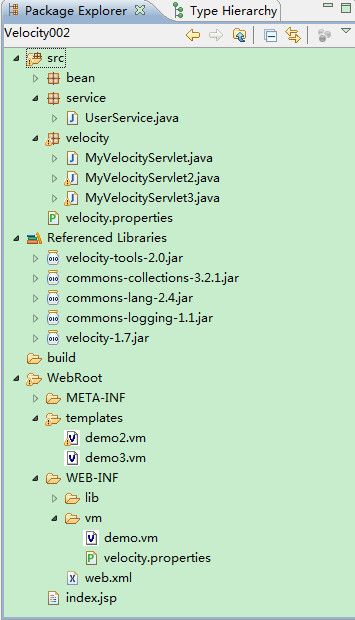Velocity之WEB(Object,List,Map)
参考资料
1 使用 Velocity 实现客户端和服务器端模板
http://www.ibm.com/developerworks/cn/java/j-velocity/
2 velocity整合servlet
http://www.blogjava.net/sxyx2008/archive/2010/11/11/337819.html
3 Velocity学习之Servlet初体验
http://jzhua.iteye.com/blog/311399
4 Velocity初体验
http://blog.csdn.net/zyk220/article/details/1927298
5 Velocity用户手册---中文版
http://blog.csdn.net/zyk220/article/details/1927304
Velocity是一个基于java的模板引擎(template engine)。它允许任何人仅仅简单的使用模板语言(template language)来引用由java代码定义的对象.
一 环境:Win7 64 + Eclipse3.7 + Tomcat6 + JDK1.6
二 工程图片如下:

三 具体实现
1 MyVelocityServlet3.java
2 velocity.properties
3 demo3.vm
4 web.xml
具体参见代码注释^_^
1 使用 Velocity 实现客户端和服务器端模板
http://www.ibm.com/developerworks/cn/java/j-velocity/
2 velocity整合servlet
http://www.blogjava.net/sxyx2008/archive/2010/11/11/337819.html
3 Velocity学习之Servlet初体验
http://jzhua.iteye.com/blog/311399
4 Velocity初体验
http://blog.csdn.net/zyk220/article/details/1927298
5 Velocity用户手册---中文版
http://blog.csdn.net/zyk220/article/details/1927304
Velocity是一个基于java的模板引擎(template engine)。它允许任何人仅仅简单的使用模板语言(template language)来引用由java代码定义的对象.
一 环境:Win7 64 + Eclipse3.7 + Tomcat6 + JDK1.6
二 工程图片如下:

三 具体实现
1 MyVelocityServlet3.java
package velocity;
import java.io.FileInputStream;
import java.io.FileNotFoundException;
import java.io.IOException;
import java.util.ArrayList;
import java.util.HashMap;
import java.util.List;
import java.util.Map;
import java.util.Properties;
import javax.servlet.ServletConfig;
import javax.servlet.http.HttpServletRequest;
import javax.servlet.http.HttpServletResponse;
import org.apache.velocity.Template;
import org.apache.velocity.app.Velocity;
import org.apache.velocity.context.Context;
import org.apache.velocity.exception.ParseErrorException;
import org.apache.velocity.exception.ResourceNotFoundException;
import org.apache.velocity.servlet.VelocityServlet;
import service.UserService;
import bean.User;
@SuppressWarnings("deprecation")
public class MyVelocityServlet3 extends VelocityServlet {
private static final long serialVersionUID = 1L;
public MyVelocityServlet3() {
}
@Override
protected void setContentType(HttpServletRequest request,
HttpServletResponse response) {
response.setContentType("text/html;charset=utf-8");
}
protected Properties loadConfiguration(ServletConfig config)
throws IOException, FileNotFoundException {
/*
* 得到属性配置文件并load它
*/
String propsFile = config.getInitParameter(INIT_PROPS_KEY);
Properties p = new Properties();
if (propsFile != null) {
String realPath = getServletContext().getRealPath(propsFile);
if (realPath != null) {
propsFile = realPath;
}
p.load(new FileInputStream(propsFile));
}
/*
* 设置velocity日志文件在web应用中的位置
*/
String log = p.getProperty(Velocity.RUNTIME_LOG);
if (log != null) {
log = getServletContext().getRealPath(log);
if (log != null) {
p.setProperty(Velocity.RUNTIME_LOG, log);
}
}
/*
* 设置模板文件在web应用中的位置
*/
String path = p.getProperty(Velocity.FILE_RESOURCE_LOADER_PATH);
if (path != null) {
path = getServletContext().getRealPath(path);
if (path != null) {
p.setProperty(Velocity.FILE_RESOURCE_LOADER_PATH, path);
}
}
return p;
}
public Template handleRequest(HttpServletRequest request,
HttpServletResponse response, Context ctx) {
//普通变量演示
String userName = "咫尺天涯";
ctx.put("userName", userName);
int userAge = 30;
ctx.put("userAge", userAge);
String blog = "http://liuzidong.iteye.com/";
ctx.put("userBlog", blog);
//JavaBean演示.
double money = 3999.89;
ctx.put("user", new User(userAge,userName,blog,money,true));
//List
List list = new ArrayList();
list.add("天涯");
list.add(30);
list.add(money);
ctx.put("list",list);
//List<User>
List<User> users = new ArrayList<User>();
users.add(new User(23,"david",blog,money,true));
users.add(new User(18,"天涯",blog,646.89,true));
users.add(new User(32,"jack",blog,2323.45,false));
ctx.put("users",users);
//Map
Map map = new HashMap();
map.put("1", "a");
map.put("2", "b");
map.put("3", "c");
ctx.put("map", map);
//Map<User>
Map<String,User> userMap = new HashMap<String,User>();
userMap.put("1",new User(23,"david",blog,money,true));
userMap.put("2",new User(18,"天涯",blog,646.89,true));
userMap.put("3",new User(32,"jack",blog,2323.45,false));
ctx.put("userMap", userMap);
//调用方法
ctx.put("userService", new UserService());
/*
* 获取模板对象,有三种可能产生的异常
*/
Template outty = null;
try {
outty = getTemplate("demo3.vm");
} catch (ParseErrorException pee) {
System.out.println("SampleServlet : parse error for template "
+ pee);
} catch (ResourceNotFoundException rnfe) {
System.out.println("SampleServlet : template not found " + rnfe);
} catch (Exception e) {
System.out.println("Error " + e);
}
return outty;
}
}
2 velocity.properties
# 指定模板文件存放目录 file.resource.loader.path = templates # 指定日志文件位置 runtime.log = log/velocity.log input.encoding=utf-8 output.encoding=utf-8
3 demo3.vm
<html>
<head><title>Demo velocity page</title></head>
<body bgcolor="#ffffff">
<br>姓名:$userName,年龄:$userAge,$userName的博客:<a href="$userBlog">$userBlog</a>
<br>年龄if elseif else end使用:
#if($userAge < 18)
未成年
#elseif($userAge >= 18 && $userAge <= 30)
青年
#elseif($userAge > 30 && $userAge <= 60)
中年
#else
老年
#end
<br>JavaBean演示:$user.getUsername(),$user.age,$user.blog,$user.momey,#if($user.xb)男#else女#end;
<br> List:
<ui>
#foreach($index in $list)
<li>$index</li>
#end
</ui>
<br> List<User>:
<ui>
#foreach($user in $users)
<li>$user.age,$user.username,<a href="$user.blog">$user.blog</a>,#if($user.xb)男#else女#end</li>
#end
</ui>
<br> Map:
<ui>
#foreach($entity in $map.entrySet())
<li>$entity.key,$entity.value</li>
#end
</ui>
<br> Map<User>:
<ui>
#foreach($entity in $userMap.entrySet())
<li>$entity.key,$entity.value.age,$entity.value.username,<a href="$entity.value.blog">$entity.value.blog</a>,#if($entity.value.xb)男#else女#end</li>
#end
</ui>
<br> 调用类方法(好强大^_^):$userService.getUserName('咫尺天涯');
<br>变量<br><textarea rows="4" cols="60">
变量的简略标记是有一个前导"$"字符后跟一个VTL标识符(Identifier.)标识符必须以一个字母开始(a...z或A...Z).
剩下的字符将由以下类型的字符组成:字母(a...z,A...Z) 数字(0...9) 连字符("-")下划线("_")
</textarea>
<br>#set ( $a ="Velocity") Hello $a World!
<br>使用$!文本框的初始值就不会是myuserName而是空值<input type="text" value="$!myuserName"/>
<br>VTL中使用"/”作为逃逸符:<br>
#set( $email ="[email protected]")
<br> $email
<br>/$email
<br>//$email
<br>///$email
#macro ( d )
<ui>
<li >1</li>
<li >2</li>
<li >3</li>
</ui>
#end
<br>macro使用:#d()
<br>
#macro ( tablerows $color $somelist $mycolor)
#foreach ( $something in $somelist )
<tr>
<td>$velocityCount</td>
#set ( $tdColor = "green")
#if($velocityCount % 2 == 0)
#set ( $tdColor = $color)
#else
#set ( $tdColor = $mycolor)
#end
<td bgcolor=$tdColor>$something</td>
</tr>
#end
#end
<br>macro常见应用:隔行变色
#set ( $greatlakes = [ "Superior", "Michigan", "Huron", "Erie", "Ontario" ] )
#set ( $color = "blue")
#set ( $color2 = "red")
<table>
#tablerows($color $greatlakes $color2)
</table>
<br>math 在模板中可以使用Velocity内建的算术函数,如:加、减、乘、除
<br>
#set ($numer = 6)
#set ( $foo = $numer + 3 )$foo<br>
#set ( $foo = $numer - 4 )$foo<br>
#set ( $foo = $numer * 6 )$foo<br>
#set ( $foo = $numer / 2 )$foo<br>
#set ( $foo = $numer % 5 )$foo<br>
</body>
</html>
4 web.xml
<servlet>
<description></description>
<display-name>MyVelocityServlet3</display-name>
<servlet-name>MyVelocityServlet3</servlet-name>
<servlet-class>velocity.MyVelocityServlet3</servlet-class>
<init-param>
<param-name>org.apache.velocity.properties</param-name>
<param-value>/WEB-INF/classes/velocity.properties</param-value>
</init-param>
<load-on-startup>1</load-on-startup>
</servlet>
<servlet-mapping>
<servlet-name>MyVelocityServlet3</servlet-name>
<url-pattern>/velocity3</url-pattern>
</servlet-mapping>
具体参见代码注释^_^